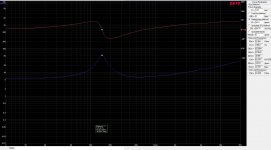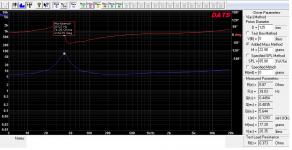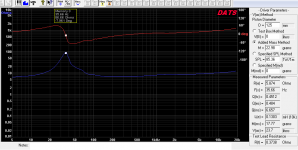Gary Pimm did some measurements on the break-in of an Alpha 6, I think. Should be on his website
When i get back home, i'll post some of my own dats measurements of TS - straight out of the box and 100 hours of break-in later.
They broke in with 50Hz. 12V ac adapter with 33ohm resistor in series with the drivers. The drivers are conected out of phase to mininise the noise coming out of them. Couple of days you just don't look at them and you measure the TS parameters after.
Then we'll se what will be the arguments in favor of "there's no break in" guys 🙂
They broke in with 50Hz. 12V ac adapter with 33ohm resistor in series with the drivers. The drivers are conected out of phase to mininise the noise coming out of them. Couple of days you just don't look at them and you measure the TS parameters after.
Then we'll se what will be the arguments in favor of "there's no break in" guys 🙂
Last edited:
Some people are so good at breaking in speakers that
these are actually fully broken at the end of the procedure.
these are actually fully broken at the end of the procedure.
Silence is golden.
Now, on the constructive side of the argument. I found on my lap top some measurements.
Here are TS for B&C 6md38 brand new and after 20 hours of breaking in. I'll post measurements after 100 hours as i promised.
Now, on the constructive side of the argument. I found on my lap top some measurements.
Here are TS for B&C 6md38 brand new and after 20 hours of breaking in. I'll post measurements after 100 hours as i promised.
Attachments
Last edited:
...side of the argument.
There doesn't need to be an argument.
Knock yourself out with T/S measurements, but you aren't breaking any new ground or proving anything.
Initial break in of driver suspension is real and nobody argues that. One can question the significance of that, though. Model the same box using both sets of parameters and you will likely find only tiny differences. Measure your T/S after x number of hours, then leave them on the shelf for x number of hours, see how much of the change is temporary. Sometimes not much, sometimes a lot of it.
Break in outside T/S land is more elusive. If you have a tightly temperature and humidity controlled space, measure anechoic frequency response (without moving the microphone or changing level, etc...) before and after breakin. see much? doubt it.
The sort of break in your hifi salesman gets into WRT amps, cables, etc.. is mostly BS. WRT speakers, it is a tactic to get you used to their sound because you will initially strongly hear their difference in spectral response and distortion character over what you listened to before.
There doesn't need to be an argument.
Knock yourself out with T/S measurements, but you aren't breaking any new ground or proving anything...
Argument=discussion - not argument in a dispute kind of way.
Initial break in of driver suspension is real and nobody argues that. One can question the significance of that, though. Model the same box using both sets of parameters and you will likely find only tiny differences. Measure your T/S after x number of hours, then leave them on the shelf for x number of hours, see how much of the change is temporary. Sometimes not much, sometimes a lot of it.
Break in outside T/S land is more elusive. If you have a tightly temperature and humidity controlled space, measure anechoic frequency response (without moving the microphone or changing level, etc...) before and after breakin. see much? doubt it.
The sort of break in your hifi salesman gets into WRT amps, cables, etc.. is mostly BS. WRT speakers, it is a tactic to get you used to their sound because you will initially strongly hear their difference in spectral response and distortion character over what you listened to before.
The difference in sound is too significant to be described merely as a matter of shifting 1-2Hz down - as clearly shown in my last post. Although effects of break-in is heard at low frequencies, most of the difference is in the midrange. Cms changes and while it does affect bass performance, midrange is impacted the most by far.
So modelling the enclosure and looking at the bass performance doesn't tell the whole story and is not the optimum way to see the effects of break-in. I suspect that sonogram will tell more then frequency response about what we here before and after say 100 working hours.
cheers
Last edited:
Since Vas and Fs are on a seesaw for the same driver when it comes to breaking in, it really doesn't matter much for loudspeaker alignment.
I can't find measurements after 100 hours so here is 6md38 after 40 hours of break-in.

On the contrary, here is SB17nrxc35-8 out of the box and 24 hours of breaking-in later:


Main change is Vas and Qms - other than that, hardly any large measurable difference. Spider and suspension on SB are very soft so i didn't expect any important changes even after 100 hours. I continued the procedure but didn't measure TS parameters when finished. Difference in sound with B&C 6md38 was enormous with 100 hours in them. Unlike them, SB showed differences in sound that could maybe be overlooked (but not neglected) if i did it with both midwoofers. I chose two midwoofers with the closest TS parameters and break-in just one. A/B testing showed difference important enough to justify the break-in procedure.
SB aside - Seas, Peerless, Beyma and other midwoofers i used showed much bigger differences in sound then one might expect. I presume that differences in sound can easily be perceived in smaller rooms. In bigger rooms more power is passed to the speakers and they tend to break-in faster.
Try it and see 🙂

On the contrary, here is SB17nrxc35-8 out of the box and 24 hours of breaking-in later:


Main change is Vas and Qms - other than that, hardly any large measurable difference. Spider and suspension on SB are very soft so i didn't expect any important changes even after 100 hours. I continued the procedure but didn't measure TS parameters when finished. Difference in sound with B&C 6md38 was enormous with 100 hours in them. Unlike them, SB showed differences in sound that could maybe be overlooked (but not neglected) if i did it with both midwoofers. I chose two midwoofers with the closest TS parameters and break-in just one. A/B testing showed difference important enough to justify the break-in procedure.
SB aside - Seas, Peerless, Beyma and other midwoofers i used showed much bigger differences in sound then one might expect. I presume that differences in sound can easily be perceived in smaller rooms. In bigger rooms more power is passed to the speakers and they tend to break-in faster.
Try it and see 🙂
Last edited:
- Status
- Not open for further replies.
- Home
- Loudspeakers
- Multi-Way
- Do speakers really need a break in period?

